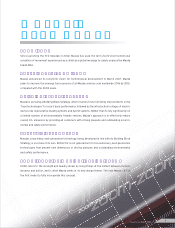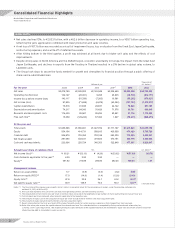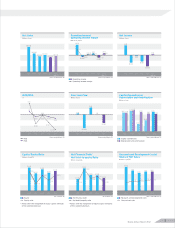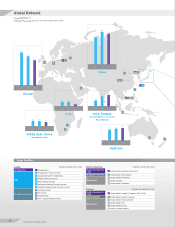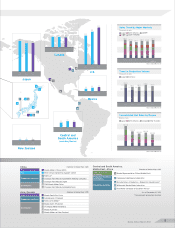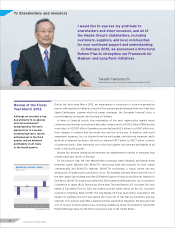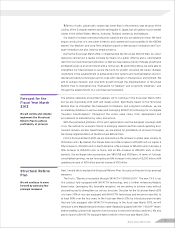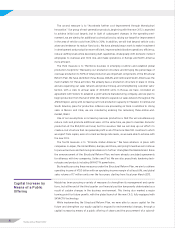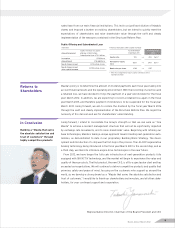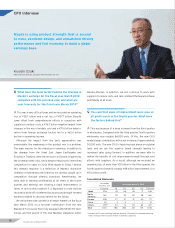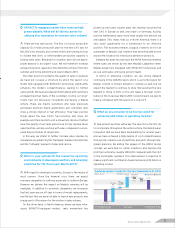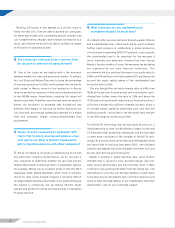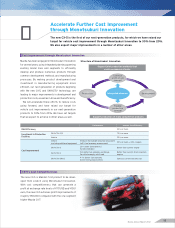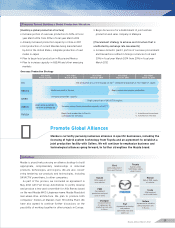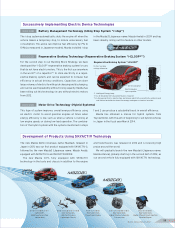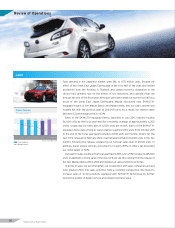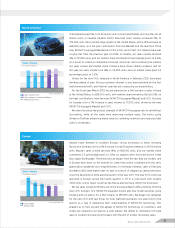Mazda 2012 Annual Report Download - page 13
Download and view the complete annual report
Please find page 13 of the 2012 Mazda annual report below. You can navigate through the pages in the report by either clicking on the pages listed below, or by using the keyword search tool below to find specific information within the annual report.
Q SKYACTIV-equipped models have received high
praise globally. What will be the key points for
utilizing this reputation to increase sales volume?
A There are two main points. The first is to boost production
capacity. Our initial production plan for the new CX-5 was for
160,000 units annually, but current orders are running at close
to double that level, so unfortunately production capacity is
holding back sales. Bringing this situation back into an appro-
priate balance is an urgent issue. We will therefore increase
annual production capacity to the 200,000 unit level from this
summer and to the 240,000 unit level in March 2013.
The other point is to enhance the quality of sales. In general,
we have put in place a structure by which the launch of a
model fully equipped with SKYACTIV technology significantly
enhances the model’s competitiveness, leading to further
sales growth. We have also learned from talking with customers
at dealerships that many of the customers visiting our show-
rooms had not previously considered purchasing a Mazda
vehicle. These are mainly customers who have previously
purchased premium brand automobiles and customers who
show a strong interest in fuel efficiency. They hear positive
things about the new CX-5’s fuel economy and drive, for
example, and then decide to visit a showroom. We must further
raise the quality of our sales and service to fully capture these
opportunities, and are working with sales companies to accel-
erate these activities at showrooms.
In this way, we intend to further increase sales volumes by
simultaneously enhancing the “hardware” element of production
and the “software” element of sales and service.
Q What is your outlook for the respective operating
environments in developed countries and emerging
countries for the fiscal year March 2013?
A With regard to developed countries, Europe is the region of
most concern. Given the financial crisis there, we expect
economic stagnation to continue, especially in southern Europe.
However we believe the impact on Mazda’s earnings will be
negligible. In addition to economic stagnation, we recognize
that last year was an off year in terms of model replacements,
and the fact that we were not able to launch new products was
a large part of the reason for the decline in sales volume.
On the other hand, in North America, where we have intro-
duced SKYACTIV-equipped models, sales momentum has
picked up and sales volume grew. We recently launched the
new CX-5 in Europe as well, and orders in Germany, Austria,
and the Netherlands were more than double the amount we
anticipated. This shows that, as in North America, there is a
very good opportunity for a turnaround to an offensive
position. The economy remains sluggish, however, but for an
automaker of Mazda’s size, I believe that we will be able to turn
around the situation by introducing attractive products.
Demand has been recovering in the North American market,
where sales are driven by the new Mazda3 (Japanese name:
Mazda Axela) fully equipped with SKYACTIV technology, and
we see solid sales continuing going forward.
In terms of emerging countries, we see strong demand
continuing in the ASEAN region, which is a priority region for
Mazda. Growth in China’s demand is slowing as well, but we
expect the market to continue to grow. We launched the new
Mazda3 in China in 2011, so this will make a full-year contri-
bution in the fiscal year March 2013. Going forward, we plan to
make a comeback with the launch of a new CX-5.
Q What do you consider to be the key point for
achieving ¥30 billion in operating income?
A New product launches will be key. The new CX-5 is the first car
to incorporate throughout the entire vehicle, the Monotsukuri
Innovation that we have been implementing for several years,
and we have achieved a high degree of cost competitiveness
through the common use of platforms and parts through inte-
grated planning. By adding the appeal of the KODO design
concept, we were able to curtail incentives and improve the
profit per vehicle by roughly ¥150,000 compared with the CX-7
in the next-higher segment. This improvement is expected to
make a significant contribution toward achieving ¥30 billion in
operating income.
(38.7)
+42.7 +3.2
(5.5) (3.8)
30.0
+32.1
Volume &
Mix
Feign
ex
C t improvements Marketing
expenses
Others
Operating Income Change For The Year Ended March 31, 2012
Billions of yen
Operating income for the
year ended March 31, 2012
Operating income for the
year ended March 31, 2011 YoY +68.7
WorsenImprove
Mazda Annual Report 2012 11


